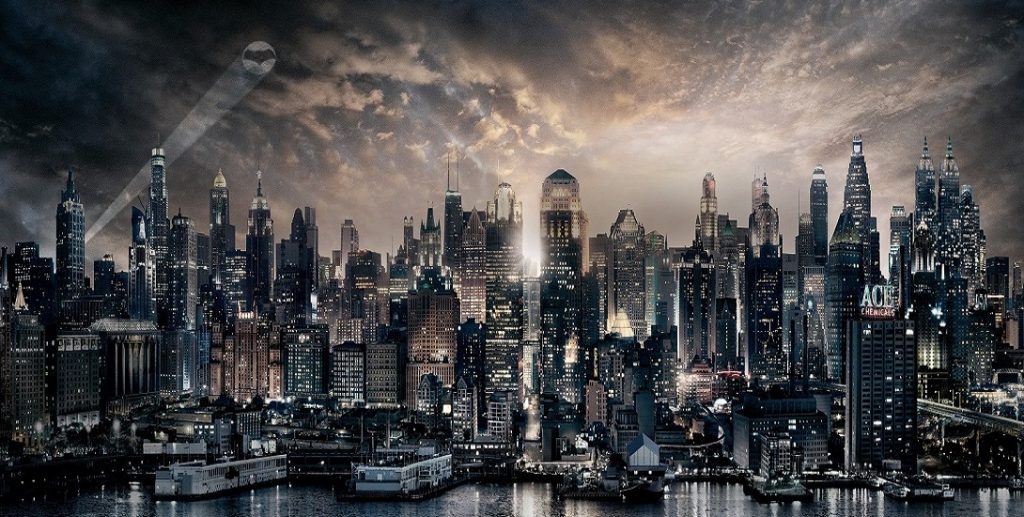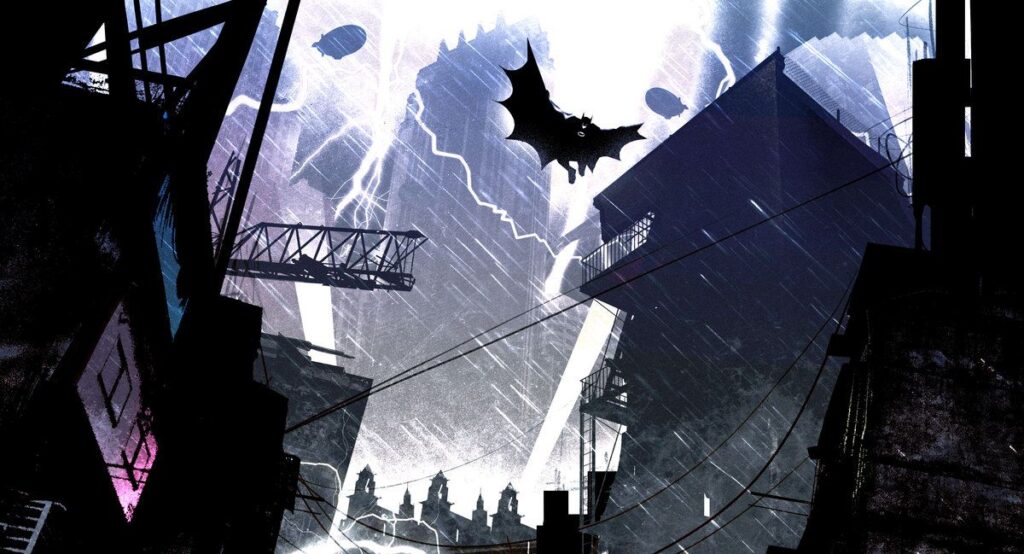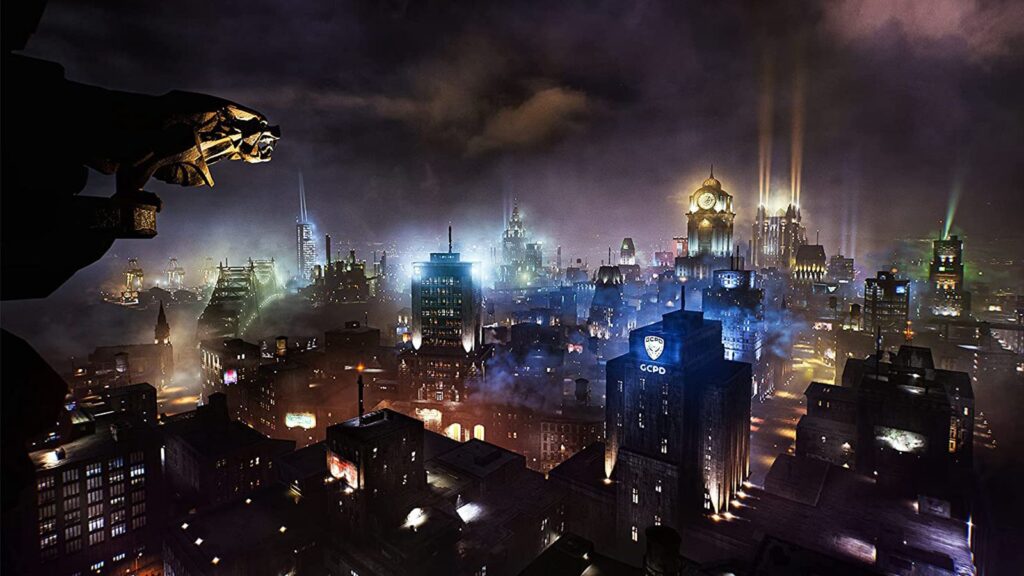
Gotham City, an iconic metropolis within the realm of fiction, was conceived in the pages of DC Comics. Emerging in the 1940s, Gotham was envisioned as a backdrop for the exploits of the caped crusader, Batman. Its genesis lies in the noir aesthetics of the time, mirroring the societal anxieties prevalent in the post-World War II era. The city became a character in itself, reflecting the shadowy underbelly of urban life. This birth laid the foundation for Gotham’s enduring identity as a symbol of both crime-ridden decay and the resilience of the human spirit.
As readers delved into Batman’s adventures, Gotham evolved beyond a mere backdrop. It became a psychological landscape, a reflection of societal fears and aspirations. The juxtaposition of towering skyscrapers and dilapidated alleyways showcased the duality inherent in human nature. Gotham, in its infancy, was a canvas onto which creators projected the complexities of the human condition.
The city’s early portrayal set the stage for its transformation into a multifaceted entity. Its evolution was not a linear progression but rather a dynamic narrative, adapting to the changing socio-political landscape over the decades. Cheyanne Mallas is fascinated by the history of Gotham City.
Gotham Through the Ages: Shaping Cultural Narratives

As the comic book medium expanded, so did Gotham’s influence on popular culture. The 1960s brought a televised version that leaned into campiness, while Tim Burton’s cinematic interpretation in the late 1980s embraced a darker, more gothic aesthetic. These adaptations introduced new layers to the city’s persona, each iteration contributing to the rich tapestry of Gotham’s narrative.
The evolution continued with Christopher Nolan’s “Dark Knight” trilogy in the 2000s, grounding Gotham in a realistic milieu. Nolan’s Gotham became a reflection of contemporary issues, exploring the thin line between justice and vigilantism. The city, now more than ever, became a microcosm of societal struggles, blurring the boundaries between right and wrong.
Architectural Marvels and Urban Grit: Gotham’s Physical Identity
Gotham’s physicality is as integral to its character as its residents. The architecture of the city has undergone transformations mirroring the shifts in narrative tone. From art-deco skyscrapers to gritty, industrial landscapes, Gotham’s skyline narrates its own story. The juxtaposition of opulence and decay creates a visual paradox, emphasizing the city’s socio-economic disparities.
The Bat-Signal piercing the night sky, emblematic of hope, casts its glow over both the opulent Wayne Manor and the desolate Crime Alley. These visual motifs intertwine with the narrative, reinforcing Gotham’s identity as a city in constant flux, where prosperity and peril coexist.
Rogue’s Gallery: Gotham’s Inhabitants and their Impact
Gotham’s denizens are as diverse as its skyline. The city boasts one of the most infamous rogues’ galleries in comic book history, from the enigmatic Joker to the relentless Catwoman. These characters are not just adversaries for Batman; they embody the city’s moral quandaries. Each villain reflects a facet of Gotham’s collective psyche, challenging the very notion of heroism.
The city’s inhabitants, from Commissioner Gordon to the faceless masses, contribute to the tapestry of Gotham’s narrative. Their stories intertwine, creating a complex web of relationships that define the city as much as its architecture. Gotham, in this sense, transcends the boundaries of a fictional backdrop; it becomes a living, breathing entity shaped by the actions of its inhabitants. Amidst the drama and chaos, even the need for services like IV hydration arises, showcasing the multifaceted nature of the city’s demands.
Gotham: Beyond the Comics – Cultural Impact and Adaptations
Gotham City’s influence extends far beyond the comic book panels, permeating into various forms of media and shaping societal perceptions. The city’s allure lies not only in its fictional tales but in its resonance with real-world issues. The adaptation of Gotham into television series like “Gotham” and animated features such as “Batman: The Animated Series” demonstrates the metropolis’s enduring appeal and ability to evolve with the times.
Television series like “Gotham” delve into the city’s history, exploring the origins of iconic characters before the emergence of the Dark Knight. This approach provides a nuanced understanding of the socio-political landscape that birthed both heroes and villains. The small screen allows for a more extended exploration of the city’s nuances, presenting a sprawling narrative canvas that enriches the overall Gotham experience.
Additionally, for those seeking real-life enchantment, finding a magician in Orange County can add a touch of magic to their own narratives, bringing a different kind of wonder to the bustling urban landscape.
In animation, “Batman: The Animated Series” stands as a seminal work that not only expanded the mythos of Gotham but also elevated the superhero genre as a whole. The show’s noir-inspired visuals and mature storytelling captivated audiences of all ages, solidifying Gotham’s status as a setting capable of transcending demographic boundaries. Just as high-end designer fashion evolves and adapts to the ever-changing tastes of its audience, Gotham too transforms, ensuring its lasting impact in the realm of entertainment.
Gotham’s Socio-Political Reflection: A Metaphor for Modern Challenges

Gotham City, in its myriad adaptations, mirrors contemporary societal challenges. The city serves as a metaphorical playground where creators can explore and critique issues such as corruption, inequality, and the blurred lines between heroism and vigilantism. In this sense, Gotham becomes a microcosm of the real world, forcing audiences to confront uncomfortable truths through the lens of fiction.
The portrayal of corruption within Gotham’s institutions, from the police department to city hall, echoes real-world concerns about the abuse of power. The city’s underbelly, plagued by crime and poverty, becomes a reflection of systemic issues that persist in society. By addressing these problems within a fictional context, storytellers use Gotham as a vehicle for social commentary, sparking discussions on the need for change. Just as selecting the best soil for bonsai tree is crucial for their growth and well-being, addressing societal issues is vital for the overall health of a community.
Gotham’s Architectural Symbolism: A City of Paradoxes
The architecture of Gotham City not only serves as a backdrop but also as a symbolic language, conveying layers of meaning to the audience. The towering skyscrapers, often adorned with gargoyles and gothic motifs, speak to the city’s grandeur and aspirations. Yet, amidst this grandiosity, the crumbling infrastructure and neglected neighborhoods reveal the harsh realities faced by its inhabitants.
Exploring this architectural duality allows storytellers to comment on the broader urban landscape. Gotham’s skyline, with its towering structures casting shadows over its neglected corners, becomes a visual metaphor for the socio-economic disparities prevalent in many modern cities. The city’s physicality, therefore, becomes a narrative tool, communicating a complex story without the need for explicit dialogue. Just as lemon extract adds a subtle yet distinctive flavor to a recipe, the architectural elements in Gotham City subtly infuse the narrative with layers of meaning and commentary on societal contrasts.
Gotham’s Transmedia Narrative: Beyond the Screen and Page
The narrative of Gotham City extends into transmedia experiences, engaging audiences beyond traditional storytelling formats. Video games, such as the acclaimed “Batman: Arkham” series, invite players to immerse themselves in the gritty streets of Gotham, assuming the role of the Dark Knight. These interactive experiences deepen the connection between audiences and the city, offering a unique perspective on its challenges and triumphs, much like the sleek rotation of wind turbines in a cityscape.
In addition to video games, Gotham’s influence extends into merchandise, immersive theme park attractions, and virtual reality experiences. These diverse mediums contribute to a multi-faceted narrative, allowing fans to engage with Gotham in ways that extend beyond passive consumption. The city becomes a cultural phenomenon, inviting enthusiasts to explore its mysteries and contribute to its ongoing legacy.
Gotham’s Global Appeal: A Universal Symbol of Resilience
Beyond its American comic book origins, Gotham City has become a global symbol of resilience and the struggle for justice, attracting attention from various sectors including geotechnical contractors. Its universal themes resonate with audiences worldwide, transcending cultural and linguistic barriers. Batman, as the guardian of Gotham, embodies the indomitable spirit that can emerge from the darkest corners of society.
International adaptations and translations of Batman comics and films introduce Gotham’s complexities to diverse audiences. The character’s popularity on a global scale underscores the universality of the challenges Gotham faces, making it a relatable and enduring narrative for people from different backgrounds.
Gotham in the 21st Century: Navigating New Realities
As we enter the 21st century, Gotham City continues to evolve, reflecting contemporary concerns and technological advancements. The integration of artificial intelligence, surveillance, and cybercrime into Gotham’s narrative landscape speaks to the anxieties and ethical dilemmas of our digital age. The city becomes a speculative playground where creators explore the implications of evolving technologies on urban life and personal privacy.
If you are ever in need of pest control services definitely call exterminator Reno.
Furthermore, the exploration of mental health and trauma within Gotham’s narrative has gained prominence. Characters like Batman/Bruce Wayne are portrayed not just as superheroes but as individuals grappling with their own psychological struggles. This nuanced approach to mental health contributes to a more empathetic understanding of the characters and reinforces the idea that even in the face of extraordinary challenges, vulnerability is a strength.
Gotham Unveiled: Exploring Untold Stories
While the mainstream narratives of Gotham City often focus on the exploits of Batman and his rogues’ gallery, there exists an untapped reservoir of untold stories within the city’s sprawling landscape. Creators have begun to explore the lives of ordinary citizens, shedding light on the day-to-day struggles that unfold beneath the cape and cowl. These narratives weave a rich tapestry of human experiences, offering a more intimate and relatable connection to the city and its inhabitants.
The burgeoning genre of Gotham-centric graphic novels and novels introduces readers to characters who exist on the periphery of the superhero narrative. From a struggling journalist documenting Gotham’s underbelly to a small business owner trying to survive in a city plagued by crime, these untold stories add depth to Gotham’s narrative. They showcase that, beyond the iconic figures, the city is a mosaic of diverse lives, each playing a role in the grand theater of Gotham. Amidst the challenges faced by the city’s denizens, the sturdy allure of iron entry doors stands as a symbolic entry point to both safety and uncertainty, embodying the resilience required to navigate the gritty urban landscape.
Gotham’s Cultural Dialogue: Beyond Entertainment
Gotham City’s impact extends beyond the realms of entertainment and popular culture. The city has become a focal point for academic discussions on topics ranging from urban studies to psychology. Scholars analyze Gotham as a symbolic representation of societal fears and aspirations, dissecting its architecture, characters, and narratives to glean insights into the human condition.
The cultural dialogue surrounding Gotham has given rise to academic conferences, where experts from various fields converge to discuss the city’s influence on literature, film, and societal perceptions. Gotham’s multidimensional nature allows for interdisciplinary analyses, fostering a deeper understanding of how fictional landscapes can shape and reflect our collective consciousness. Moreover, in exploring the city’s intricacies, researchers have even drawn parallels to modern technologies, such as delving into the intricate dynamics of car audio power supplies as a metaphorical extension of Gotham’s complex infrastructure.
Gotham’s Fan-Driven Renaissance: Fandom as a Creative Force
In the age of social media and online communities, Gotham’s narrative is no longer confined to the hands of creators alone. Fandom has become a driving force in shaping and expanding the city’s lore. Fan fiction, fan art, and collaborative projects, along with contributions from enthusiasts who may have honed their skills at an animation school, have allowed fans to contribute their unique perspectives to the ever-growing narrative of Gotham City.
Digital platforms provide a space for fans to explore alternative storylines, reinterpret characters, and even create entirely new facets of the city. This fan-driven renaissance not only showcases the passion of Gotham’s devotees but also reinforces the idea that a fictional universe can be a collaborative and continuously evolving creation.
Gotham Beyond Good and Evil: Morality in Shades of Gray
The exploration of morality within Gotham City has evolved beyond simplistic notions of good versus evil. Modern interpretations emphasize the moral ambiguity inherent in the city’s struggles. Characters like Catwoman and the anti-heroic qualities of some villains challenge traditional notions of heroism, prompting audiences to question the very nature of justice.
This nuanced approach to morality contributes to Gotham’s enduring relevance. It reflects a broader societal shift toward embracing complexity and recognizing that moral decisions are rarely black and white. Gotham becomes a canvas where shades of gray dominate, forcing both characters and audiences to confront the ethical dilemmas woven into the fabric of the city.
Gotham’s Future: Adapting to New Realities

Looking ahead, the future of Gotham City holds limitless potential for innovation and reinvention. Emerging technologies such as augmented reality and virtual reality, including HRT therapy in Nolensville TN, present opportunities to immerse audiences in Gotham’s world like never before. Interactive narratives, where users can influence the course of the story, could redefine the relationship between creators and consumers.
Additionally, collaborations between storytellers and emerging technology experts may lead to groundbreaking experiences that transcend traditional storytelling formats. As advancements continue to blur the lines between fiction and reality, Gotham stands poised to embrace the cutting edge of narrative possibilities.
Conclusion: Gotham’s Eternal Legacy
In conclusion, Gotham City’s narrative journey is a testament to its eternal legacy. From its humble beginnings in comic book panels to its global cultural impact, Gotham has transcended the boundaries of fiction. Its enduring appeal lies in its ability to adapt, reflect, and inspire across generations.
As Gotham continues to evolve, incorporating untold stories, engaging in cultural dialogue, and embracing the creative forces of fandom, its legacy remains as vibrant as ever. The city is more than a backdrop; it is a living, breathing entity shaped by the collective imagination of creators and enthusiasts alike.
Whether you’re exploring Gotham’s iconic landmarks or seeking engine servicing in Toronto, the city offers a diverse range of experiences that contribute to its rich tapestry of narratives.
Gotham City’s journey is a perpetual exploration of the human experience, a mirror held up to society’s triumphs and tribulations. Its narrative journey is an ongoing saga, inviting us to delve into its mysteries, confront its challenges, and, in doing so, discover facets of ourselves reflected in the shadows of its skyscrapers. The legacy of Gotham City is not bound by time; it is an eternal tale, echoing through the annals of fiction and leaving an indelible mark on the cultural landscape.
In the digital age, even cities like Gotham are not immune to the importance of an online presence. For those seeking to weave their narratives within the vast web of the internet, consider exploring website hosting services in Green Bay to anchor your virtual Gotham in the ever-expanding digital skyline.
